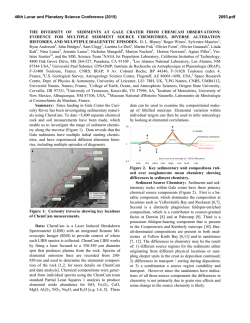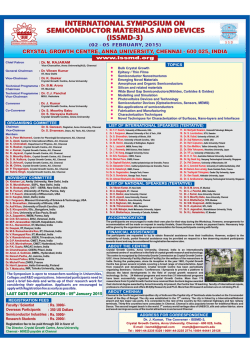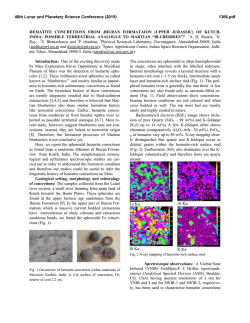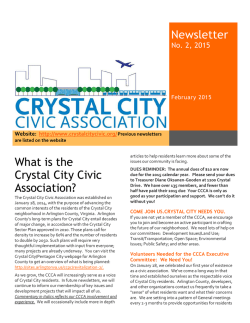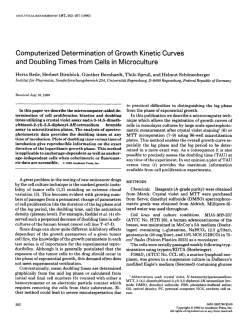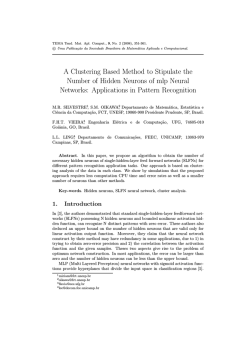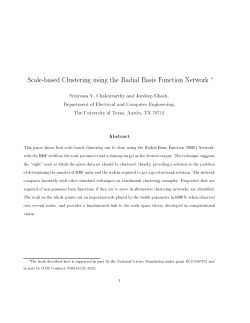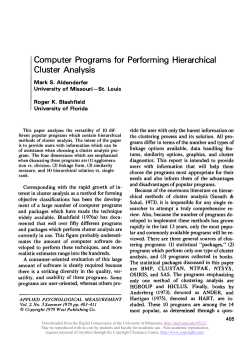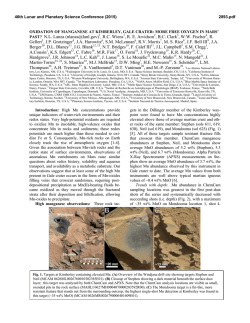
Diagenetic Crystal Clusters and Dendrites, Lower - USRA
46th Lunar and Planetary Science Conference (2015) 1901.pdf DIAGENETIC CRYSTAL CLUSTERS AND DENDRITES, LOWER MOUNT SHARP, GALE CRATER. L.C. Kah1, R. Kronyak1, J. Van Beek2, M. Nachon3, N. Mangold3, L. Thompson4, R. Wiens5, J. Grotzinger6, J. Farmer7, M. Minitti8, J. Shieber9, D. Oehler10; 1University of Tennessee, Department of Earth and Planetary Sciences, Knoxville, TN 37996; [email protected]; 2Malin Space Science Systems, San Diego, CA; 3CRNS, Nantes, France; 4 University of New Brunswick, New Brunswick, Canada; 5LANL, Los Alamos, NM; 6California Institute of Technology, Pasadena, CA; 7Arizona State University, Tempe, AZ; 8Planetary Science Institute, Tucson, AZ; 9Indiana University, Bloomington, IN; 10Johnson Space Center, Houston, TX. Introduction: Since approximately Sol 753 (to sol 840+) the Mars Science Laboratory Curiosity rover has been investigating the Pahrump locality. Mapping of HiRise images suggests that the Pahrup locality represents the first occurrence of strata associated with basal Mount Sharp. Considerable efforts have been made to document the Pahrump locality in detail, in order to constrain both depositional and diagenetic facies. D rectangular cross-section; the three dimensional morphology of the crystal clusters cross-cut laminae within the host rock with little or no deformation (Fig. 3). A B C D C A B Figure 1. Pahrump section [mcam03229] showing distribution of diagenetic crystal clusters and dendrites. Features are most abundant near the base of the section and were imaged at Shoemaker (A), Confidence Hills (B) and Pink Cliffs (C) locations. Localtions are shown relative to Whale Rock (D), which is ~10 m above the base of the Pahrump section. The Pahrump succession (Fig. 1) consists of approximately 13 meters of recessive-weathering mudstone interbedded with thin (decimeter-scale) intervals of more erosionally resistant mudstone, and crossbedded sandstone in the upper stratigraphic levels. Mudstone textures vary from massive, to poorly laminated, to well-laminated. Here we investigate the distribution and structure of unusual diagenetic features that occur in the lowermost portion of the Pahrump section. These diagenetic features consist of three dimensional crystal clusters and dendrites (Fig. 2) that are erosionally resistant with respect to the host rock. Distribution and Structure of Crystal Clusters: Crystal clusters and dendritic features occur in the lowermost portion of the Pahrump succession, between Shoemaker and Pink Cliffs localities (Fig. 1) and are particularly visible in the low relief exposures at Confidence Hills. Crystal clusters consist of ~2 cm diameter groups of elongate lathes that typically occur within individual blocks of the fractured substrate. Individual lathes show tabular morphologies with a pserudo- Figure 2. Diagenetic crystal clusters and dendrites. (A,B) Crystal clusters occur primarily within individual blocks of the fractured substrate [from 0753MR0032370090403734E01 and 0753MR0032370090403730E01, respectively]. (C,D) Dendritic forms are commonly larger, and often associated with mineralized fractures [ from 0753MR0032370090403732E01 and 0753MR0032370090403733E01, respectively]. Figure 3. Diagenetic crystal clusters within laminated mudstone at Shoemaker. Host rock shows no indication of deformation during crystal growth. [from 0799MR0034930040500192E01] Dendritic structures are generally larger (branches often >3 cm along growth direction) that crystal clusters and show predominantly planar growth— potentially aligned with bedding planes. As with crystal clusters, individual lathes within the dendrites are elongate and pseudo-rectangular in cross-section. Unlike crystal clusters, dendritic morphologies appear to 46th Lunar and Planetary Science Conference (2015) nucleate at bedrock fractures and mineralized veins (cf. Fig. 2). These fractures may have been integral in the transport of ions responsible for dendrite growth. Additional details appear when viewed with the Mars Hand Lens Imager (MAHLI). First, within dendrites, individual lathes record uniform divergence angles between 87-89° (Fig. 4). Such uniformity in divergence angle suggests that this reflects the original growth. If diverging lathes represent twinning, the crystal angles are consistent with a number of evaporite minerals, including anhydrite and magnesium sulfate. Second, despite a uniformity in apparent crystal divergence, little textural evidence remains to aid in the diagnoses of original mineral form. Features are more resistant to erosion that the surrounding bedrock, but remain relatively soft (as seen by scratch marks made by the Curiosity rover’s Dust Removal Tool (DRT) (Fig. 4). Individual lathes also show little evidence of discrete crystal faces. Rather, a bumpy, or nodular surface structure suggests either differential erosion of the diagenetic features, or perhaps modification of crystal faces by secondary nucleation points. Additionally, MAHLI images of DRT-brushed regions, there is little difference in color or microscale texture between the crystal clusters and surrounding bedrock, both appear to be grey in color lathes appear to incorporate grains from the surrounding host material. A B Figure 4. MAHLI images of diagenetic features at Pahrump. (A) The dendrite “Mammoth” with primary lathe orientations highlighted in yellow. (B) The crystal cluster “Meonkopi” reveals clear scratch marks where brushed by the DRT. Although more erosionally reisitant than the surrounding outcrop, these diagenetic features do not appear to have unusual hardness. Red circle in both images is the apparent footprint of the APXS. Chemistry of Crystal Clusters and Dendrites: Several of the diagenetic features described here were targeted for analytical exploration by ChemCam/LIBS and APXS. Chemcam targeted two individual dendritic features, as well as two adjacent clusters. In all cases, LIBS analyses noted clear enrichment of magnesium (Mg), as well as a variety of sulfur (S) peaks. APXS also targeted several locations at the Confidence Hills locality, including a bedrock target (“Maturango”) and two diagenetic features (the large dendrite “Mammoth” 1901.pdf and a cluster “Moenkopi”). Both Maturango and Moenkopi were analyzed post-DRT. Mammoth was still dust-covered at the time of APXS analysis. APXS Analyses confirm measurements of Chemcam/LIBS and show enrichment of the diagenetic features in Mg and S (estimated 10% MgSO4). APXS also noted substantial enrichment in both nickel (Ni >1900 ppm) and zinc (Zn >3000 ppm). The Maturango bedrock target is broadly similar to other low-alkali bedrock targets (e.g. Bathurst, Winjana, John Klein), although a bit higher in silica (>50% by weight). Bedrock targets also show a clear enrichment in Ni (1156 ppm) and Zn (1732), although these enrichments are less than that observed in the diagenetic crystal clusters and dendrites. Summary and Interpretation: Observations provided here show that crystal clusters and dendrites are nucleated both within the host mudstone and at the edges of fractures. Nucleation associated with fractures commonly results in larger, more dendritic features. Although these features are more erosionally resistant than the host mudstone, they are still able to be scratched by the DRT and sometimes appear to incorporate grains from the host rock. These features also appear to grow without deformation of laminae within the host mudstone, and are enriched in MgSO4, Ni, and Zn over the host rock. We suggest that diagenetic crystal clusters and dendrites are post-depositional, potentially burial diagenetic features. Association of these features with both throughgoing fractures as well as unfractured bedrock suggests that fluids associated with their formation permeated the rock matrix Larger structures associated with fractures may represent greater fluid flow and delivery of ionic constituents. Origin of nucleation remains uncertain. Some diagenetic alteration of the host rock is supported by enrichment of Ni and Zn not observed in other low-alkali rock targets. Absence of any clear deformation of laminae within the host rock suggests that growth of these diagenetic clusters proceeded as interparticle crystal growth. In such a scenario, the mineral phase would consist of poikilotopic (i.e., grain encompassing) growth through the mudstone matrix. Mineral growth within interparticle spaces will commonly result in regions of porosity loss with little further effect on the rock matrix. Crystal clusters and dendrites are most likely to form when mineral saturation states are highest, for instance with initial intrusion and mixing of fluid sources. Evidence for continued mineralization at Pharump—not directly associated with crystal clusters and dendritic forms— may be represented be enhanced resistivity individual laminae throughout the Pahrump mudstone.
© Copyright 2026
